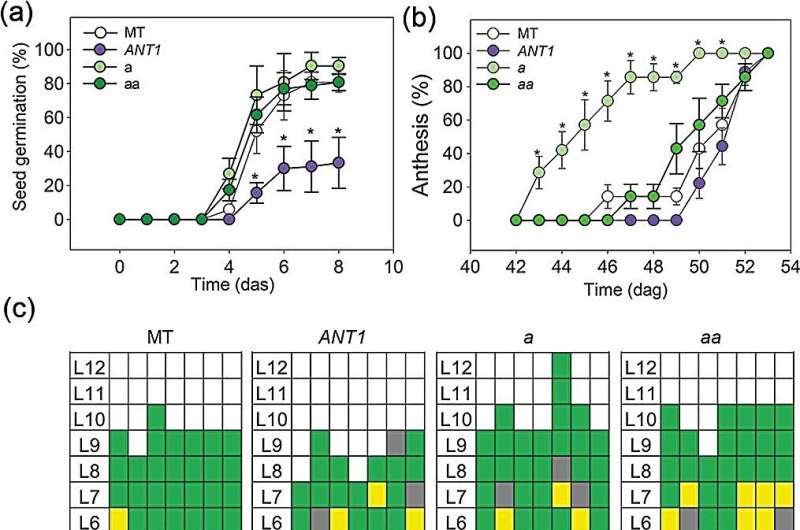This article has been reviewed according to Science X's editorial process and policies. Editors have highlighted the following attributes while ensuring the content's credibility:
fact-checked
peer-reviewed publication
trusted source
proofread
Decoding anthocyanin impact: Genetic insights into plant defense and growth trade-offs

Anthocyanins are key pigments in plants for plant resistance to abiotic stress. It can provide photoprotection by potentially absorbing visible light and scavenging reactive oxygen species (ROS) when biotic stress occurs. However, comparative studies of anthocyanin function are challenged due to the absence of isogenic plant models with variable anthocyanin levels.
Genetic advances in tomatoes have identified the ANTHOCYANIN1 (ANT1) gene, a MYB transcription factor of tomato (Solanum lycopersicum), offering a promising avenue for study. The critical problem remains determining the primary protective mechanism of anthocyanins in plant photosynthesis.
Horticulture Research published a perspective titled by "Promoter replacement of ANT1 induces anthocyanin accumulation and triggers the shade avoidance response through developmental, physiological and metabolic reprogramming in tomato."
In this study, germination rates were first compared to examine the effects of anthocyanin overproduction on plant growth and development. Results revealed that the seeds of ANT1 plants (promoter replacement of ANT1) with high anthocyanin content had significantly lower germination rates than the control (MT) and anthocyanin-deficient mutants (a and aa).
Flowering times and vegetative growth were also affected, with ANT1 showing delayed flowering and reduced vertical growth post-flowering. The number of side branches and total leaf area was notably reduced in ANT1 plants. Productivity was assessed in ANT1 and its hybrids with M82, showing that despite similar soluble solids content, fruit yield was reduced due to smaller fruit size and fewer fruits per plant.
Light absorbance and leaf structure analyses revealed that the spectral properties of ANT1 leaves were altered, with increased absorbance in the blue and red ends of the spectrum and structural differences such as differential elongation of the palisade parenchyma and reduced thickness of both epidermis leading to leaf thickness.
Gas exchange properties were also investigated to understand the impact of anthocyanin on photosynthesis. ANT1 plants showed lower rates of photosynthesis and transpiration, as well as reduced carboxylation and electron transport rates. Furthermore, high anthocyanin levels in ANT1 provided photoprotection under high light conditions, maintaining more stable photosystem II efficiency (Fv/Fm).
Transcriptomic analysis indicated that anthocyanin accumulation led to altered expression of genes associated with shade avoidance response (SAR). ANT1 plants showed differential expression of photoreceptor genes, SAR regulators, and other genes affecting morphology and signaling. Lastly, metabolic profiling across ANT1 plants and their hybrids uncovered that certain carbohydrate levels were elevated while many amino acid concentrations were lower in ANT1, with some organic acids mildly increased.
In conclusion, this study not only advances our understanding of anthocyanin's roles in plant physiology but also provides a promising avenue for the use of anthocyanin manipulation in crop breeding to optimize plant growth and productivity.
More information: João Victor Abreu Cerqueira et al, Promoter replacement of ANT1 induces anthocyanin accumulation and triggers the shade avoidance response through developmental, physiological and metabolic reprogramming in tomato, Horticulture Research (2022). DOI: 10.1093/hr/uhac254
Journal information: Horticulture Research
Provided by NanJing Agricultural University




















